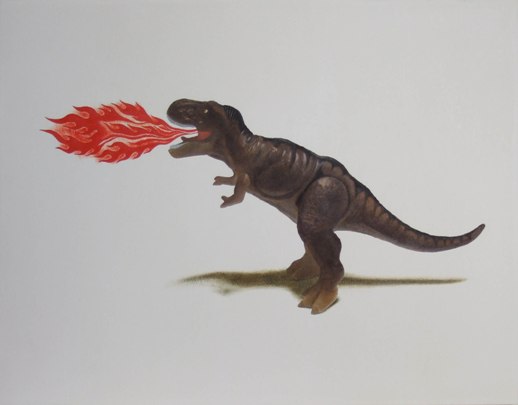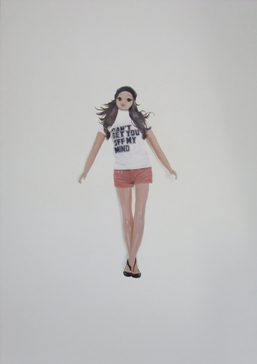The Line of Artifice
The title of this exhibition was certainly fitting when I visited; after a confused trawl through Ginza’s side streets, I arrived too early, and spent a good ten minutes sporadically jiggling the doorknob, not realising that the gallery behind it was one of those tiny, white, one-room galleries Tokyo does so well. The owner ushered me in finally, bemused at my eagerness. Embarrassed at my impatience, it was an ‘uneasy space’ indeed.
The startling brightness of the gallery is intensified by the sharp white backgrounds in Hiroe’s pieces, mostly punctuated with kawaii or toy figures. Some pieces were modeled on dolls and clothes from fashion magazines, and they resemble any typical Shinjuku girl; dead-eyed, lip-glossed, with shiny and floppy limbs. The blank white space where their neck should be, however, spoils their innocuous sheen and follows the tradition in Japanese art of clearly displaying the line of artifice. One is unsure whether Hiroe here is merely representing or criticising kawaii culture, yet there is the lurking suggestion that their real-life counterparts are as shallow and empty as the dolls themselves. All of the canvases are wrapped in clear plastic, giving them the flimsy sheen of gift-wrapped goods ready for consumption.

 There are also paintings of furry toys, rendered so meticulously they leap out from the canvas. Yet once again spoiling the illusion, they are stamped with a red inkan by means of signature, and are again covered in plastic. Hiroe states that, as a result of his training in France, he strives to juxtapose the two-dimensional and three-dimensional aspects traditionally found in Japanese and Western art respectively. He is concerned with depth, reality, and constructions.
There are also paintings of furry toys, rendered so meticulously they leap out from the canvas. Yet once again spoiling the illusion, they are stamped with a red inkan by means of signature, and are again covered in plastic. Hiroe states that, as a result of his training in France, he strives to juxtapose the two-dimensional and three-dimensional aspects traditionally found in Japanese and Western art respectively. He is concerned with depth, reality, and constructions.
Thus it is with the title piece of the exhibition, in which toy soldiers surround a burning house painted in a stylised and graphic way, like an icon. The juxtaposition of the serious topic and play figures creates a queasy disharmony, much like Yoshitomo Nara’s nefarious children with cheeky grins and blood on their hands. But while the two artists are similar in their use of a kawaii aesthetic to bring out the absurd, Hiroe’s images are far more distant and sterile than Nara’s. Although playful, they are somewhat emotionless and ambivalent, with the white background first dazzling the eyes before the interplay between three dimensional and two dimensional aspects can sink in.
My favourite piece was that of a small hollow toy whose head was replaced with a red stamp of a rabbit, comically disproportionate and flat compared to the body. In the background lies a one-line drawing of a house’s outline. The meaning is obscure, but the aesthetic effect is easily appreciable. In this respect, despite claiming to involve Western elements in his work, Hiroe is a thoroughly modern Japanese artist, prioritising surface over message, cuteness over gravity. Yet this is to its merit rather than its detriment, with his meticulous painting style and unique presentation making this exhibition well worth a look - just don’t arrive too early…
Sophie Knight
Sophie Knight



